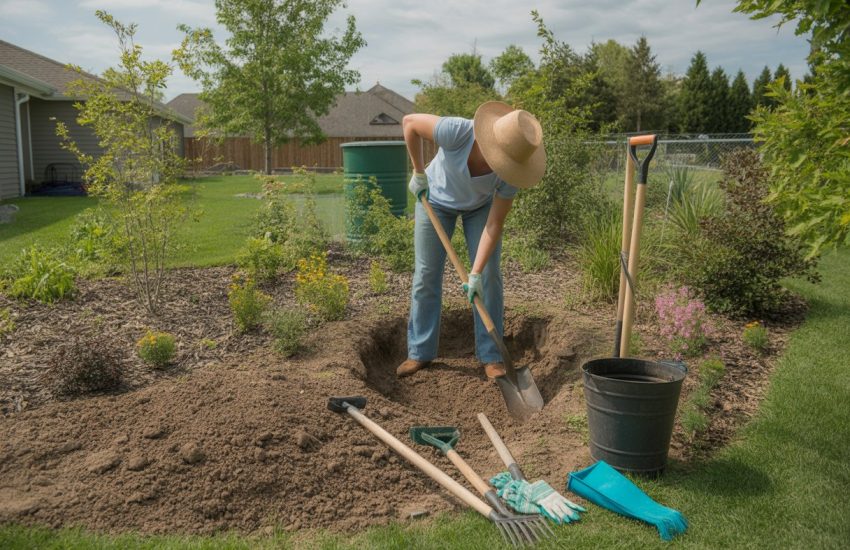Our Favorite Ground Cover Plants to Grow in Illinois
Ground covers are an important part of any landscaping plan. Not only do they add visual interest, but they also help to control erosion and weeds. In addition, ground covers can provide valuable habitats for wildlife. There are many types of ground covers to choose from, so it is important to select the one best suited for your landscape. For example, if you live in an area with a lot of foot traffic, you might want to choose a ground cover that is tolerant of being trampled on. If you have a large area to cover, you might want to consider a fast-growing ground cover. Most importantly, you should select a ground cover that will thrive in your locality. Here are some cover plants suitable for Illinois.
The Best Ground Cover Plants to Grow in Illinois
Mayapple (Podophyllum Peltatum)
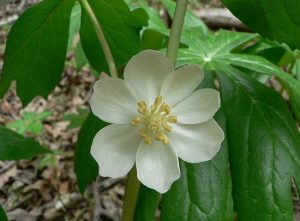
The Mayapple (Podophyllum peltatum) is a herbaceous perennial plant native to the woodland areas of North America. The plant gets its common name from the small, white flowers that bloom in early spring, often before the leaves have fully emerged. The flowers are followed by light green fruits that ripen to yellow or orange in late summer. The Mayapple is a low-growing plant with stout stems and large, umbrella-like leaves. The leaves are borne on long stalks and can reach up to two feet in diameter. Mayapples are typically found growing in colonies, as the plants reproduce both vegetatively and via seed dispersal. Although the fruits of the Mayapple are edible, they are quite bitter and should only be eaten when fully ripe. The plant’s roots contain a compound called podophyllotoxin, which has been used in cancer treatments. This would make for a good cover plant due to its extensive root system.
Barrenwort (Epimedium Grandiflorum)
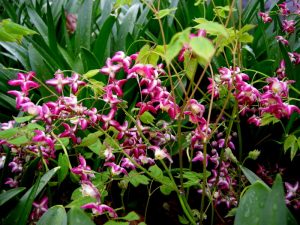
Barrenwort (Epimedium grandiflorum) is a herbaceous perennial native to China. It is an evergreen ground cover plant with heart-shaped leaves and beautiful flowers blooming in the spring. The plant gets its common name, “barrenwort,” from its purported ability to increase libido in men. The plant is also known as “bishop’s hat” because of its shape and textured leaves. The active ingredients in barrenwort are thought to be a group of compounds known as icariin derivatives. These compounds have been shown to have a variety of beneficial effects on the human body, including enhancing blood circulation, boosting immune function, and protecting against oxidative stress. Barrenwort is a fast-growing ground cover plant that spreads quickly by rhizomes. It can grow in full sun to partial shade and prefers well-drained soil. Barrenwort is an excellent choice for ground cover in areas that are difficult to mow or where you want a low-maintenance plant. It also does well in rock gardens and as an understory plant in woodlands.
Lungwort (Pulmonaria Sacharata)
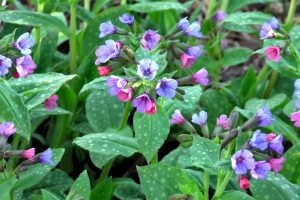
Pulmonaria sacharata, more commonly known as lungwort, is a herbaceous perennial that is part of the Boraginaceae family. It is native to Europe and parts of Asia but can now be found in other parts of the world. Lungwort is a low-growing plant that typically reaches about 30 cm in height. The leaves are lobed and covered in dots, which are expanded trichomes. These trichomes help to protect the leaves from damage by herbivores. The flowers of lungwort are pink, blue, or purple, and they bloom in the springtime. After the flowers fade, the plant produces fruits that contain seeds. Lungwort is often used as an ornamental plant, but it also has a number of traditional medicinal uses. Lungwort (Pulmonaria sacharata) is an excellent ground cover for a number of reasons. First, it is very dense and effectively blocks weeds and other unwanted plants. Second, it has a deep root system that helps to hold the soil in place and prevent erosion. Third, its leaves are covered with tiny hair-like structures that help to trap moisture, making it an ideal plant for dry or shady areas. Lungwort is easy to care for and can be propagated by division or seed. It is hardy in most climates and tolerates both full sun and partial shade.
Sedges (Carex spp.)
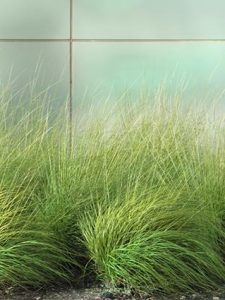
Sedges (Carex spp.) are a diverse group of perennial flowering plants that can be found in nearly every habitat on Earth. Despite their ubiquity, sedges are often overlooked due to their relatively unassuming appearance. However, these plants play an important role in ecosystems worldwide, serving as food for wildlife, stabilizing soil, and preventing erosion. Sedges typically have narrow, sword-shaped leaves and small, inconspicuous flowers. The leaves are arranged in a spiral around the stem, and the flowers are borne in clusters at the tips of the stems. There are over 1,500 species of sedge, ranging in size from a few inches to several feet tall. Most sedges prefer moist habitats, but some species can tolerate dry conditions. Sedges are an important food source for many animals, including rabbits, deer, and birds. The roots of sedges also help to stabilize soils and prevent erosion. In gardens, sedges can be used as a ground cover or as accents in flowerbeds. With their wide range of sizes and preferences, there is a sedge species that can suit nearly any landscape.
Creeping Juniper (Juniperus spp.)
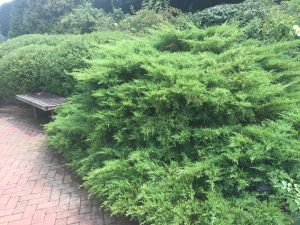
Creeping juniper (Juniperus spp.) is a low-growing, evergreen shrub native to North America. It is commonly found in the western United States and grows in dry, rocky habitats. Creeping juniper is a member of the genus Juniperus, which contains more than 60 species of coniferous trees and shrubs. Most of these species are native to the Northern Hemisphere, with a few being found in Africa, North America, and South America. Juniperus spp. are characterized by their needle-like leaves and small, spherical cones. The leaves of creeping juniper are arranged in whorls of three to five needles. Each needle is sharp-tipped and measures 1-2 centimeters in length. The cones are globular in shape and measure 1-2 centimeters in diameter. They are green when immature and turn brown or gray when mature. Creeping juniper reproduces via seed cones or vegetatively from stem cuttings. It is often used as an ornamental plant, ground cover, or hedge in landscaping projects. Creeping juniper is tolerant of a wide range of growing conditions and can be found in sunny and shady locations. It is also drought-tolerant and does not require much watering once established. However, it is not tolerant of salty conditions and should not be planted in areas where salt water or de-icing chemicals are applied to the ground.
Red Columbine (Aquilegia Canadensis)
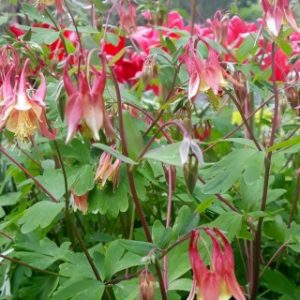
Red columbine (Aquilegia canadensis) is a beautiful flower native to North America. It gets its name from its showy red flowers, accented by yellow stamens. The blooms appear early to mid-summer and are a favorite of pollinators such as bees and butterflies. The foliage is green and divided into deeply lobed leaves. The Red columbine is a member of the buttercup family and is related to the European Columbine (Aquilegia vulgaris). The plant is a perennial, meaning it will come back year after year. Red columbine prefers to grow in shady areas, such as woods or under trees. It is also quite tolerant of deer and other herbivores, making it a good choice for gardeners who want to add color without worrying about animal damage. Red columbine is a relatively low-maintenance plant, but it requires some care to ensure it thrives. For best results, water regularly and fertilize yearly with a balanced fertilizer. With proper care, red columbine will provide years of beauty in the garden.
Japanese Pachysandra (Pachysandra Terminalis)
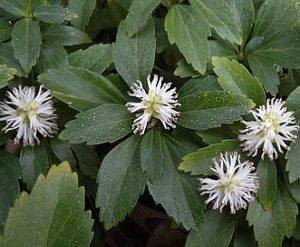
Pachysandra terminalis, also known as Japanese pachysandra, is an evergreen groundcover that is native to Japan. It is a low-growing plant that spreads quickly, making it an ideal choice for covering large areas of ground. The leaves of Japanese pachysandra are oval-shaped and glossy green, with a white stripe running down the center. In early spring, small white flowers bloom in clusters at the ends of the stems. Although it is not considered to be a particularly attractive plant, Japanese pachysandra is prized for its ability to thrive in shady areas where other plants would quickly succumb to the lack of sunlight. It is also relatively tolerant of foot traffic, making it a good choice for groundcover in areas that are likely to be disturbed, such as along paths and walkways.
Periwinkle (Vinca Minor)
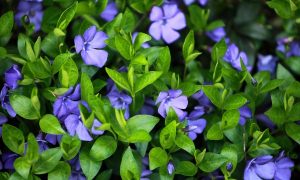
Periwinkle (Vinca minor) is a fast-growing, evergreen groundcover that is native to Europe. It has glossy, dark green leaves and produces small, blue flowers in early spring. Periwinkle is very tolerant of shade and drought, making it an ideal plant for areas that are difficult to maintain. It can spread quickly, so it is important to keep it trimmed if you do not want it to take over your garden. Periwinkle is also deer resistant and cold hardy, making it a good choice for gardeners in northern climates. Although it is generally a low-maintenance plant, periwinkle can be susceptible to fungal diseases in humid conditions. To prevent problems, water only at the base of the plant and avoid getting the leaves wet.
Canadian Wildginger (Asarum Canadense)
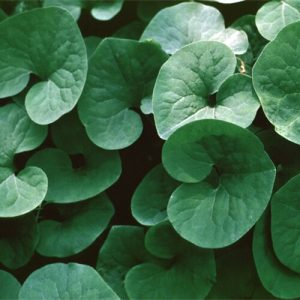
Asarum canadense, also known as Canadian wildginger, is a species of flowering plant in the ginger family. It is native to eastern North America, from Newfoundland to North Carolina. The plant has dark green, heart-shaped leaves and small, brownish-purple flowers that bloom in spring. Canadian wildginger is often found in woodlands and forest edges. It is a herbaceous perennial that grows 10-20 cm tall. The root system consists of rhizomes that spread laterally just below the soil surface, forming dense mats. This species is rhizomatous, meaning it can reproduce vegetatively via its rhizomes. Asarum canadense has been used traditionally by Indigenous Peoples for medicinal purposes. The plant is believed to have healing properties and was used to treat a variety of ailments such as colds, flu, stomach problems, and toothaches. Canadian wildginger is still used today in some herbal remedy preparations.
Virginia Strawberry (Fragaria Virginiana)
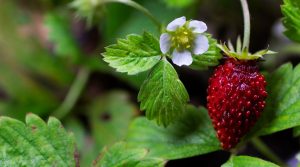
Fragaria virginiana, also known as the wild strawberry, is a small herbaceous plant that is native to North America. The plant has a rosette of leaves and produces small white flowers. The fruit of the plant is a small red berry that is delicious and nutritious. The berries are often used in jams and pies or simply eaten fresh. Wild strawberries are a key ingredient in the traditional French dessert, fraises des Bois. The plant grows best in well-drained, sandy soils and is often found in woodlands, fields, and meadows. Fragaria virginiana is a valuable addition to any garden, and its berries are sure to please even the most discerning palate.
Care and Maintenance
Ground covers are a versatile and low-maintenance option for adding greenery to your landscape. Once they are established, ground covers require little care beyond the occasional trimming to keep them looking neat. The best time to trim most ground covers is in late spring or early summer after they have finished blooming. Use sharp shears or Garden shears to make clean, angled cuts just above the level of the soil. Most ground covers will need little supplemental irrigation. Fertilize ground covers in early spring with a slow-release fertilizer or compost. Mulch around the plants to help retain moisture and control weeds. For ground covers that spread aggressively, such as ivy or vinca, you may need to dig up and divide the plants every few years to prevent them from taking over your garden bed. With a little effort, you can enjoy a beautiful ground cover that adds visual interest and helps to control weeds.
Pest and Diseases
Ground covers are susceptible to many of the same pests and diseases that affect other types of plants. Aphids, for example, are a common problem for gardeners of all kinds. These small, sap-sucking insects can weaken plants and make them more susceptible to other problems. Regular spraying with insecticidal soap or neem oil is usually effective in controlling aphids. Powdery mildew is another common issue that can affect ground covers. This fungal disease causes a white powder to form on the leaves of affected plants. While powdery mildew is not usually fatal, it can cause the leaves to yellow and drop off prematurely. To prevent powdery mildew, avoid overwatering your ground covers and ensure they have plenty of air circulation. If powdery mildew does appear, spraying with a solution of baking soda and water can help to control it. With proper care, most ground covers will remain healthy and pest-free.

